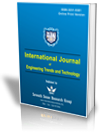High-Quality Synthesis of Terephthalamide from Secondary PET Waste
High-Quality Synthesis of Terephthalamide from Secondary PET Waste |
||
 |
 |
|
| © 2025 by IJETT Journal | ||
| Volume-73 Issue-4 |
||
| Year of Publication : 2025 | ||
| Author : Saidnazarov T. R, Turaev Kh. Kh, Karimov M.U, Kasimov Sh.A, Akhatov A.A |
||
| DOI : 10.14445/22315381/IJETT-V73I4P132 | ||
How to Cite?
Saidnazarov T. R, Turaev Kh. Kh, Karimov M.U, Kasimov Sh.A, Akhatov A.A, "High-Quality Synthesis of Terephthalamide from Secondary PET Waste," International Journal of Engineering Trends and Technology, vol. 73, no. 4, pp.396-405, 2025. Crossref, https://doi.org/10.14445/22315381/IJETT-V73I4P132
Abstract
The article studies the two-step process of Terephthalamide synthesis, which is used to produce various polymers, pigments, and antioxidants. In the production of Terephthalamide, the relevant raw material, terephthalic acid, was synthesized from PET waste using a high-yield reaction method. Terephthalamide was synthesized from the obtained terephthalic acid. The effect of pressure, mass ratio of starting materials, temperature, and catalyst was studied to increase the reaction yield. Graphs and diagrams were constructed according to the reaction results. At the same time, the IR spectrum and Raman spectrum of the obtained Terephthalamide were obtained and analyzed. Also, the molecular structure, dynamics of intermolecular interactions, and thermal properties were studied using NMR analysis, TGA, and DTA analysis methods. Based on the results of the analysis, it was proven that the product obtained was terephthaldiamide.
Keywords
Polyethylene terephthalate (PET), Glycerin, Ethylene glycol, Urea, Reactor autoclave, Reaction product, Amination, Terephthalamide, DEF, DMSO.
References
[1] Zixian Jia et al., “Chemical Recycling of Pet to Value-Added Products,” RSC Sustainability, vol. 1, no. 9, pp. 2135-2147, 2023.
[CrossRef] [Google Scholar] [Publisher Link]
[2] Daniel Paszun, and Tadeusz Spychaj, “Chemical Recycling of Poly (Ethylene Terephthalate),” Industrial and Engineering Chemistry Research, vol. 36, no. 4, pp. 1373-1383, 1997.
[CrossRef] [Google Scholar] [Publisher Link]
[3] George P. Karayannidis et al., “Chemical Recycling of Pet by Glycolysis: Polymerization and Characterization of the Dimethacrylated Glycolysate,” Macromolecular Materials and Engineering, vol. 291, no. 11, pp. 1338-1347, 2006.
[CrossRef] [Google Scholar] [Publisher Link]
[4] Jifeng Pang et al., “Synthesis of Ethylene Glycol and Terephthalic Acid from Biomass for Producing PET,” Green Chemistry, vol. 18, no. 2, pp. 342-359, 2015.
[CrossRef] [Google Scholar] [Publisher Link]
[5] Hung Lin Lee, Chi Wen Chiu, and Tu Lee, “Engineering Terephthalic Acid Product from Recycling of Pet Bottles Waste for Downstream Operations,” Chemical Engineering Journal Advances, vol. 5, pp. 1-14, 2021.
[CrossRef] [Google Scholar] [Publisher Link]
[6] M. Volanti et al., “Terephthalic Acid from Renewable Sources: Early-Stage Sustainability Analysis of a Bio-Pet Precursor,” Green Chemistry, vol. 21, no. 4, pp. 885-896, 2019.
[CrossRef] [Google Scholar] [Publisher Link]
[7] Lelia Cosimbescu et al., “Simple but Tricky: Investigations of Terephthalic Acid Purity Obtained from Mixed Pet Waste,” Industrial and Engineering Chemistry Research, vol.60, no. 35, pp. 12792-12797, 2021.
[CrossRef] [Google Scholar] [Publisher Link]
[8] Behrouz Shojaei, Mojtaba Abtahi, and Mohammad Najafi, “Chemical Recycling of Pet: A Stepping‐Stone Toward Sustainability,” Polymers for Advanced Technologies, vol. 134, no. 12, pp. 2912-2938, 2020.
[CrossRef] [Google Scholar] [Publisher Link]
[9] Robert D. Allen, and Martin I. James, Chemical Recycling of Pet, Circular Economy of Polymers: Topics in Recycling Technologies, American Chemical Society, vol. 1391, pp. 61-80, 2021.
[Google Scholar] [Publisher Link]
[10] Mohammad Khoonkari et al., “Chemical Recycling of Pet Wastes with Different Catalyst,” International Journal of Polymer Science, vol. 2015, pp. 1-11, 2015.
[CrossRef] [Google Scholar] [Publisher Link]
[11] Vijaykumar Sinha, Mayank R. Patel, and Jigar V. Patel, “Pet Waste Management by Chemical Recycling: A Review,” Journal of Polymers and the Environment, vol. 18, no. 1, pp. 8-25, 2008.
[CrossRef] [Google Scholar] [Publisher Link]
[12] D.S. Achilias, and G.P. Karayannidis, “The Chemical Recycling of Pet in the Framework of Sustainable Development,” Water, Air and Soil Pollution: Focus, vol. 4, no. 4, pp. 385-396, 2004.
[CrossRef] [Google Scholar] [Publisher Link]
[13] Dimitris I. Collias et al., “Biobased Terephthalic Acid Technologies: A Literature Review,” Industrial Biotechnology, vol. 10, no. 2, pp. 91-105, 2014.
[CrossRef] [Google Scholar] [Publisher Link]
[14] Myung Jong Kang et al., “Depolymerization of Pet into Terephthalic Acid in Neutral Media Catalyzed by the ZSM-5 Acidic Catalyst,” Chemical Engineering Journal, vol. 398, 2020.
[CrossRef] [Google Scholar] [Publisher Link]
[15] G.P. Karayannidis, A.P. Chatziavgoustis, and D.S. Achilias, “Poly (Ethylene Terephthalate) Recycling and Recovery of Pure Terephthalic Acid by Alkaline Hydrolysis,” Advances in Polymer Technology, Journal of the Polymer Processing Institute, vol. 21, no. 4, pp. 250-259, 2002.
[CrossRef] [Google Scholar] [Publisher Link]
[16] R.K. Soni, and Swati Singh, “Synthesis and Characterization of Terephthalamides from Poly (Ethylene Terephthalate) Waste,” Journal of Applied Polymer Science, vol. 96, no. 5, pp. 1515-1528, 2005.
[CrossRef] [Google Scholar] [Publisher Link]
[17] Yusufjon Eshkobilovich Nazarov et al., “Bis(8-Hydroxyquinolinium) Napht Halene-1,5-Disulfonate Tetrahydrate,” Iucr Data, vol. 9, no. 6, pp. 1-9, 2024.
[CrossRef] [Google Scholar] [Publisher Link]
[18] Gulnora A. Umirova et al., “Crystal Structure and Hirshfeld Surface Analysis of 8-Azaniumylquinolinium Tetrachloridozincate (II),” Crystallographic Communications, vol. 79, no. 9, pp. 856-861, 2023.
[CrossRef] [Google Scholar] [Publisher Link]

